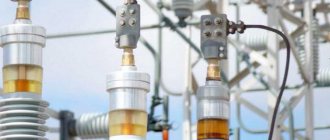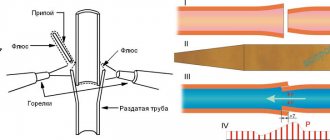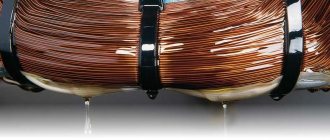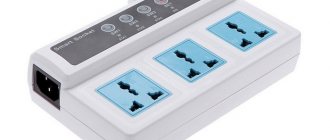For electrical insulation of cables and wires, a modern consumable material called electrical insulating tape or electrical tape for short is used. Back in the mid-20th century, chemists and engineers created self-adhesive tape based on polyvinyl chloride. But it was difficult to apply this development in practice due to the fact that the plasticizer made it too oily and destroyed all adhesives, and also the technical characteristics of PVC electrical tape , which we will discuss in this article, were not fully studied.
In January 1946, company representatives developed a new version of the film based on rubber and without sulfur. The first electrical tapes were made in white and yellow colors. Under the influence of ultraviolet light, the white tape changed its color and over time it was replaced with black. Over the 60 years of its existence, electrical tape has undergone as many as 17 significant changes.
What is electrical tape
The abbreviated name of the material “insulating tape” is derived from the full name “insulating tape”. The main purpose is to isolate problematic areas.
Externally, it is a plain blue or black tape with one or two adhesive sides. However, other color variations are acceptable on the market today. Electrical tape can be used in domestic or industrial applications.
Technical data
The material is quite strong and differs in different characteristics: type, grade and manufacturing features. Let's look at the standard data:
- Temperature restrictions: - 30 and + 60 degrees.
- Stretch up to 150 percent.
- Permissible voltage - up to 5000 V.
- Permissible load - 14.7 MPa.
Thanks to the above advantages, it has great prospects. Easily withstands temperature changes, high levels of humidity and electrical load.
Other benefits
Electrical tape is a worthy choice for the following reasons:
- Sticks well;
- Current resistant;
- Tolerates any temperature;
- No toxic substances;
- Durable and elastic;
- Moisture resistant;
- Does not ignite;
- Affordable price.
The technical features of the insulation tape have made this product popular enough for use by beginners or professionals.
However, many people wonder: is it possible to use regular adhesive tape instead of insulating tape? At first glance, this saves money and time. But common wisdom confirms that such material is not suitable for electrical wiring.
Dacron tape
Heat-resistant insulating tapes made from polyester raw materials, called lavsan, exhibit good consumer qualities at moderate temperature loads.
They have good adhesion to steel, high mechanical strength, resistance to electricity, and can be operated without problems at negative temperatures reaching 25 ℃ below zero, positive temperatures up to 150 ℃.
Manufacturing process
Production takes place in accordance with GOST standards. A wide range of materials are used in pure or combined form: polyvinyl chloride or cotton raw materials. These are common materials widely used in various fields of work.
Natural materials, woven materials that provide electrical conductivity, deserve special attention. There are a wide variety of electrical tapes on the market with their own pros and cons.
Type and use of electrical tape
The product is divided into several types, differing in grade and materials used. The product is based on various fabrics and polyvinyl chloride. The first material produces durable and heat-resistant products.
There are cotton products that are not considered insulating. Their area of application is towing. Next, we will consider the popular materials from which electrical tapes are made.
PVC
Well-known and in demand material. The product has a smooth surface; the manufacturer uses blue or red color. We are talking about the same electrical tape that was used back in the last century.
Has the following characteristics:
- Width - from 14 to 20 mm;
- Voltage withstand up to 5000 V;
- Temperature withstand - from - 30 to + 50 degrees;
- Possibility of extension up to 150%.
This is a universal, high-strength material with an operating voltage of 0.4 kV.
The material is less durable and weather-resistant, but is used for simple installation. Often used with the previous above product to improve reliability.
cotton fabric
- Voltage withstand up to 1000 V;
- Operating temperature from - 30 to + 30 degrees, storage from 0 to 24 degrees;
- Low elasticity.
This type of product is more often used in the household sector than in the industrial sector. Often used at high temperatures, which causes the electrical tape to ignite and harden.
This provides a protective coating. Due to its electrical conductivity and the above-mentioned characteristics, CB tape is widely in demand in the market.
From lavsan
Not the most common choice, but the material has acceptable strength indicators and reacts normally to weather changes; it is used at moderate temperatures.
Adapts well to metal surfaces and is quite resistant to mechanical damage. Can be used additionally with PVC electrical tape.
Silicone, fiberglass
A product made from such materials is quite reliable due to its high strength. Used for household electrical appliances and other powerful equipment (withstands up to 300 degrees).
Melting temperature
Tape storage temperature is from +5 to +40 degrees Celsius. It can also be used with higher parameters. Of course, you won’t be able to wind it in the cold - it will simply “stuff.” As the manufacturers assure, the maximum heating temperature should not exceed +80 degrees. Melting occurs only with an open flame. If we talk about high-quality tape, it can withstand heat up to +150 degrees, although the properties are lost.
You may be interested in: Types and uses of heating electric cable
Based on the official characteristics, the maximum resistance of the tapes is maintained when heated to +105 degrees. If the joint of the wires is of poor quality or the load is greater than normal, the tape will begin to melt.
Electrical specialists put forward their recommendations: to make the twisting as high quality as possible, first glue the fabric insulation, and only then PVC. The first does not melt when heated, and the second protects from moisture.
This is what “burnt” insulation looks like
Electrical tape is a practical consumable used to protect connections. The main thing is to choose it correctly, based on specific working conditions. Knowing what PVC electrical tape is made of, it is easier to decide on this issue. However, no one forbids using several types of tapes at once to achieve the desired result, each with its own properties.
Where applicable
The material is widely used in engineering, construction, and installation work. This is also used to mark and secure electrical or internet cables.
In general, the main task is connection and isolation. Some consumers believe that regular packing tape can be used. However, this material is not intended for securing electrical or other wires.
It cannot withstand temperature pressure and begins to melt. Therefore, you should not use it for serious tasks.
Duct tape
Adhesive tape, very popular abroad, is gaining popularity here. It is a polyethylene film coated with a thick layer of glue and reinforced with fabric. It sticks well, is easily torn by hand, is not afraid of water, thanks to the fabric reinforcement it does not stretch and has good tensile strength. It is with this tape that the villains in Hollywood films seal the victim’s mouth.
Roll of reinforced adhesive tape
Most often used for emergency repairs of things, it can also be used for temporary electrical insulation, but in low-voltage installations - aluminum powder, which gives the tape a gray color, makes the electrical insulating properties of the tape low. It burns well, which is extremely undesirable for electrical insulation.
Other methods of operation
On thematic forums you can learn about standard methods of using insulating tape. However, such material has found wide application in non-standard areas of activity.
You only need your own ingenuity to use the material as follows:
- If, under unexpected circumstances, someone is injured and there is no bandage at hand, it is worth trying to apply a tourniquet with electrical tape.
- When carrying out painting work, you can also use electrical tape.
- Spending time in the forest is sometimes fraught with ticks and other insects that usually crawl up your sleeves. There is a creative way to solve this problem: wrap your sleeves with electrical tape.
- Is a rug or track constantly moving when you walk? Then use double-sided tape and secure the product for safe movement.
- When transporting objects, it is difficult to find a rope. Insulating tape will do its job just as well as rope.
During repair work, electrical tape not only plays a functional role. Often used to highlight interior decoration.
Purpose
Due to its versatility, this material is used in various areas of human activity. It is applicable both outdoors and indoors. In stores you can find ribbons of different colors, but the main thing is that they do not have any unpleasant odors - this indicates low quality.
You might be interested in Tire colors by phase
PVC tape is not recommended for insulating polymers or silicone surfaces that contain fluorine. If the surface to be treated has defects, pores or other damage, it must first be prepared by applying a primer material. PVC tape is applied only to a dry and clean surface.
Key function is insulating
Areas of use:
- work with electrical engineering. Electrical cables are insulated with tape, wires are connected, and bundles are marked;
- household work. PVC tape is useful if you need to repair various things, from tools to other household items;
- car repair. For example, if necessary, insulate wires and other places;
- package. Thanks to the adhesive coating, this tape makes it easy to pack small boxes. Packaging work is increasingly being automated;
- boat repair. To do this, use a special reinforced tape;
- pipeline protection. Pipes laid in the ground are constantly affected by the negative influences of the soil, so pipelines require reliable protection. PVC insulation helps protect the outside of pipes from rust. But here it is important to use it correctly, namely, wind it in a spiral to avoid distortions. The tape, resistant to moisture, waterproofs the highways.
This is not the entire list of areas where electrical tape is used. In addition to repair work, it is also widespread in creative activities.
It is also used in design
A Question of Choice
Before purchasing a tool, it is always wise to check its specifications and other features. You should take into account the wide range of types of insulating tapes.
In this case, we start from width, length, material, grade and adhesion. And most importantly, we define our goals.
Restoring size
After stretching, good electrical tape should restore its original dimensions after a certain time. To test this characteristic, take a square hollow box and stretch some tape between its edges.
After this, place a heavy, evenly shaped object on top of them so that it applies equal pressure to each strip in the row.
To create more force, you can forcefully press it down with your hand.
Apply pressure for a few seconds. Next, remove the object and observe the result and the speed of restoration of size.
The tape that will return to its previous length most quickly will be the best.
Cheap models will not be able to recover to normal sizes at all and will remain sagging like ropes.











